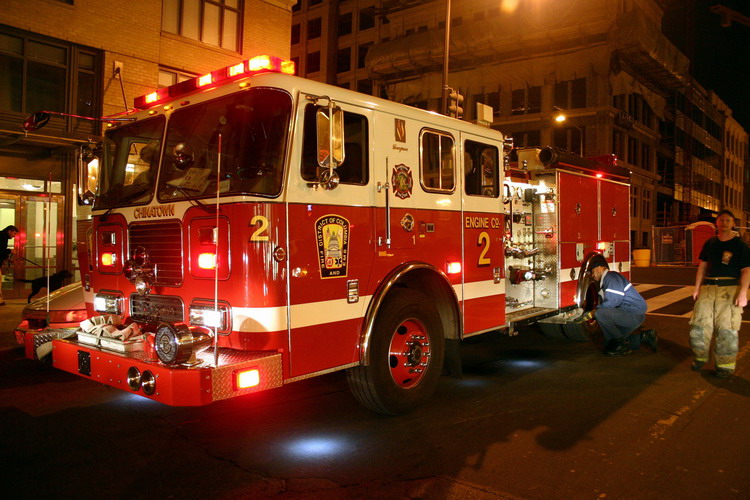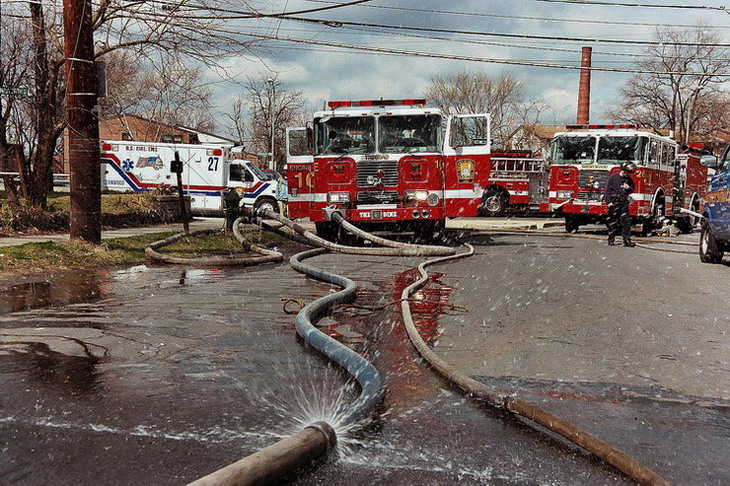Posts: 748
Threads: 0
Likes Received: 2 in 2 posts
Likes Given: 0
Joined: Aug 2006
Reputation:
3

The DCFD ordered twenty wagons for 2002-2003: fourteen from Seagrave and six from Pierce. The first 10 Seagraves came in early 2003. They had 1250 GPM 2-stage Waterous pumps and 500-gallon water tanks. Shop serials 136 through 145 went to Engines 2, 3, 18, 26, 27, 30, 9, 10, 15, and 32.
The first ’02 Seagrave went to Engine 2, shop serial 136. March 10, 2007 photo
Kevin Byrne
Posts: 748
Threads: 0
Likes Received: 2 in 2 posts
Likes Given: 0
Joined: Aug 2006
Reputation:
3

Engine 27’s 2002 Seagrave S-140.
Kevin Byrne
Posts: 748
Threads: 0
Likes Received: 2 in 2 posts
Likes Given: 0
Joined: Aug 2006
Reputation:
3

2002 Seagrave S-141 went to E-30. Photo taken on the fireground June 19, 2007
Kevin Byrne
Posts: 748
Threads: 0
Likes Received: 2 in 2 posts
Likes Given: 0
Joined: Aug 2006
Reputation:
3

2002 Seagrave wagons of Engines 10 and 26 (S-143 and 139) on the fireground March 3, 2004
Kevin Byrne
Posts: 748
Threads: 0
Likes Received: 2 in 2 posts
Likes Given: 0
Joined: Aug 2006
Reputation:
3

Engine Co. 10
Kevin Byrne
Posts: 748
Threads: 0
Likes Received: 2 in 2 posts
Likes Given: 0
Joined: Aug 2006
Reputation:
3

Engine Co. 15 received shop serial S-144 in 2003. It was subsequently reassigned to Engine Co. 28 in 2005. Photo taken on the fireground July 5, 2007
Kevin Byrne
Posts: 748
Threads: 0
Likes Received: 2 in 2 posts
Likes Given: 0
Joined: Aug 2006
Reputation:
3

Engine 32 on the scene of a house fire at 1st St. and Xenia St. SE, May 30, 2007; the wagon is 2003 Seagrave S-145. S-145 was the final delivery on the first batch of '02-'03 Seagrave wagons.
Kevin Byrne
I was told at one time that DCFD Wagons had 550 feet of 1 3/4" preconnected (and from the looks of some of your pictures, it looks like it)...is this a backup line? What pressures do they pump? I was always told that you couldn't get better than about 100 GPM past 300 feet in 1 3/4" line...
Great shots of DCFD rigs...love to see the business end and how they are all set up. Thanks for sharing!
Posts: 748
Threads: 0
Likes Received: 2 in 2 posts
Likes Given: 0
Joined: Aug 2006
Reputation:
3
[quote name='phyrngn' post='127336' date='Jul 8 2007, 21:52 ']I was told at one time that DCFD Wagons had 550 feet of 1 3/4" preconnected (and from the looks of some of your pictures, it looks like it)...is this a backup line? What pressures do they pump? I was always told that you couldn't get better than about 100 GPM past 300 feet in 1 3/4" line...
Great shots of DCFD rigs...love to see the business end and how they are all set up. Thanks for sharing![/quote]
DCFD limits choices: one either pulls an 1 ½” or a 2 ½”. The longest preconnected hand line is the 350’ 1 ½” off the back step. The modus operandi for the first-due engine is speed in placing a line in service. A good company can stretch a 350’ and extend it with two “standpipe racks” to create a 550’ line very rapidly, while the larger lines or multiple lines are laid in (it’s happened on occasion and I’m guessing that’s where your 550’ number came from). DC uses 125-GPM CVFSS nozzles for 1 1/2". You can get the GPM in an exotic hose layout – just do the math and don’t exceed 300 PSI engine pressure.
Kevin Byrne
Posts: 452
Threads: 6
Likes Received: 0 in 0 posts
Likes Given: 0
Joined: Jun 2006
Reputation:
0
[quote name='dcfireman' post='127349' date='Jul 8 2007, 22:58 ']DCFD limits choices: one either pulls an 1 ½” or a 2 ½”. The longest preconnected hand line is the 350’ 1 ½” off the back step. The modus operandi for the first-due engine is speed in placing a line in service. A good company can stretch a 350’ and extend it with two “standpipe racks” to create a 550’ line very rapidly, while the larger lines or multiple lines are laid in (it’s happened on occasion and I’m guessing that’s where your 550’ number came from). DC uses 125-GPM CVFSS nozzles for 1 1/2". You can get the GPM in an exotic hose layout – just do the math and don’t exceed 300 PSI engine pressure.[/quote]
Ahh good old hydraulics..Did almost exactly the above at Dunbar HS. Second due, I was ECC. Stretch the 350, added a standpipe rack and we did beat E-6 on water. Hot day, was running an old Hahn (the infamous 90's!!!) lifted the jumpseat engine covers and got tid of the heat.
Thank God those Hahns held up. And coming from a Mack man!!!!!
Stay safe, Brothers.
Kill 'em all, let Allah sort 'em out. NEVER forget 9/11/01 WTC, Pentagon, Pa. Avenge the acts with NO mercy.
Thanks to ALL the Brothers who were there 9/11/01 and afterwards. Words can never say what appreciation we have for you all.
I should mention that some of the companies have decided to keep their long line at 400' in the rear bed instead of 350', due to numerous instances of crazy apartment complexes. <img src='http://www.firepics.net/groupboards/public/style_emoticons/<#EMO_DIR#>/smile.gif' class='bbc_emoticon' alt='  ' />
Posts: 748
Threads: 0
Likes Received: 2 in 2 posts
Likes Given: 0
Joined: Aug 2006
Reputation:
3
[quote name='ResQguy' post='127353' date='Jul 8 2007, 23:05 ']I should mention that some of the companies have decided to keep their long line at 400' in the rear bed instead of 350', due to numerous instances of crazy apartment complexes. <img src='http://www.firepics.net/groupboards/public/style_emoticons/<#EMO_DIR#>/smile.gif' class='bbc_emoticon' alt='  ' />[/quote]
I have to admit I was partial to having a long line myself. When you're second or fourth-due you can run your own hand line down the block and be sure of getting water. You can't always trust that other driver to give you water when you yank one of HIS hand lines, and his company is in front of you.
Kevin Byrne
[quote name='smketrfdny' post='123365' date='Jun 27 2007, 23:43 ']Kevin, when did they go to the Humat? I recall those stupid, bulky Akron valves that really werent that well liked.,..
Surprised to see a Humay in DC...................[/quote]
DC went to the Humat valve because Akron stopped making the 'Akron valve' which DC used.
I personally much preferred the old Akron valve to the Humat valve. The Akron valve was of much better construction than the Humat valve, and it wasn't as bulky either.
[quote name='dcfireman' post='120993' date='Jun 20 2007, 17:45 '] ![[Image: attachment.php?thumbnail=20106]](http://firepics.net/MyBB/attachment.php?thumbnail=20106)
The reduced water tank size made for easier access to the hose on the Cyclone IIs. This image compares Engine 2’s 1996
Cyclone with Engine 8’s 2000 Cyclone II. The February 4, 2001 image views south on 5th St. at L St. SW -- Box Alarm in the
1200 block of 5th St, SW.[/quote]
That is the 1100 block of 5th St. SE, not the 1200 block of 5th St. SW. That building is no longer there as the majority of that neighborhood has been torn down and is being redeveloped as part of the Anacostia Riverfront Initiative.
[quote name='dcfireman' post='123335' date='Jun 27 2007, 22:56 ']Wasn't that ex-E-25? Do you know what E-3 ended up with (S-196 or S-195)?[/quote]
E-3 received E-16's old Cyclone when they were reopened.
[quote name='dcfireman' post='122528' date='Jun 25 2007, 20:50 '] ![[Image: attachment.php?thumbnail=20338]](http://firepics.net/MyBB/attachment.php?thumbnail=20338)
In this photo taken on 01-23-07, E-21’s 2000 Cyclone II (S-120) was at the end of its first-line use though only seven years old. This is not to say anything bad about the manufacturer; it is the nature of running a 15-ton aluminum body rig thousands of times a year.[/quote]
This isn't E-21's original 2000 Cyclone II if it was taken in 2007. Their 2000 wagon was severely damaged in an accident and had a new cab put on it. When it came in after the repair it was assigned to the training academy. I forget who's 2000 Cyclone II was given to E-21 to be their regular wagon after the accident. The repaired wagon has the newer Cyclone II cab, and you can tell it from the others by the rounded edges on the top of the front grill rather than the totally square ones on all of the other Cyclone II's.
[quote name='dcfireman' post='126941' date='Jul 8 2007, 00:32 '] ![[Image: attachment.php?thumbnail=21005]](http://firepics.net/MyBB/attachment.php?thumbnail=21005)
Here’s a view comparing the evolution of the DCFD back step. On the left is a 1996 E\-One Cyclone with a 750-gallon tank. On the right is a 2000 Cyclone II with a 500-gallon water tank. The water tank was made smaller to lower the hose bed. February 2007 photo, DCFD Training Academy[/quote]
The E-35 in this photo is probably the repaired 2000 Cyclone II which originally was assigned to E-21.
[quote name='dcfireman' post='127349' date='Jul 8 2007, 22:58 ']DCFD limits choices: one either pulls an 1 ½” or a 2 ½”. The longest preconnected hand line is the 350’ 1 ½” off the back step. The modus operandi for the first-due engine is speed in placing a line in service. A good company can stretch a 350’ and extend it with two “standpipe racks” to create a 550’ line very rapidly, while the larger lines or multiple lines are laid in (it’s happened on occasion and I’m guessing that’s where your 550’ number came from). DC uses 125-GPM CVFSS nozzles for 1 1/2". You can get the GPM in an exotic hose layout – just do the math and don’t exceed 300 PSI engine pressure.[/quote]
Some DC wagons run with 400' instead of 350' on their 'long line' preconnect.
Posts: 748
Threads: 0
Likes Received: 2 in 2 posts
Likes Given: 0
Joined: Aug 2006
Reputation:
3
[quote name='Jaws' post='127374' date='Jul 9 2007, 00:52 ']That is the 1100 block of 5th St. SE, not the 1200 block of 5th St. SW. That building is no longer there as the majority of that neighborhood has been torn down and is being redeveloped as part of the Anacostia Riverfront Initiative.[/quote]
Wow - you can read my writing better than I can! I must remember that when crossing the Mall and/ or South Capitol St. meridians, all the addresses go backwards! <img src='http://www.firepics.net/groupboards/public/style_emoticons/<#EMO_DIR#>/banghead.gif' class='bbc_emoticon' alt='  ' />
Kevin Byrne
Without a chart close at hand...that should be 250 psi and 300 psi roughly for the 300 and 500 foot 1.5's. Personally, I don't buy into the argument of letting the truck work easier at lower pump pressures bit. I paid x amount of dollars.....it better pump what it's supposed to. It's good to see places like DC making the truck work hard to get lines in service. Does anywhere else in the U.S. or Canada operate like this that you know of? Most places are always trying to keep pressure down. Anyway, apologies for hi-jacking the thread.
|






 ' />
' />
 Facebook
Facebook Google
Google Reddit
Reddit Twitter
Twitter